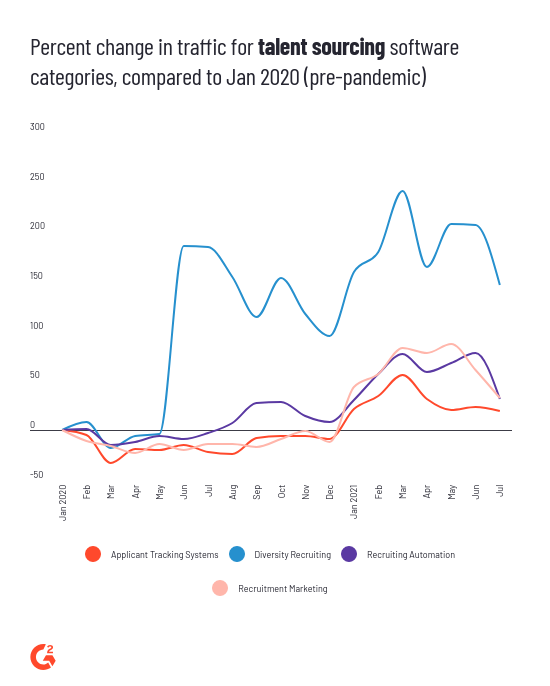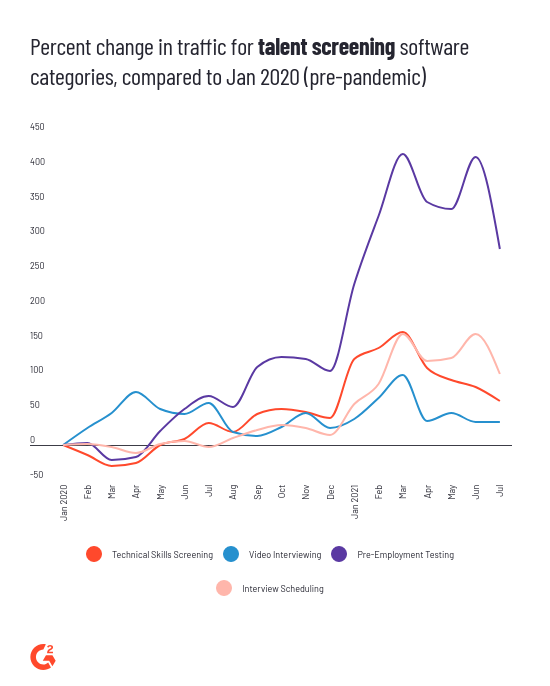For most jobs, there had always been an in-person component to the hiring process. It might have started with an online application, then a phone or video interview, but typically a candidate came in to see the office or interview in person as the process progressed.
As COVID-19-related lockdowns impacted businesses worldwide, in-person recruiting became difficult or impossible and recruiters were forced to get creative. One outcome of that was a rise in virtual hiring events.
To acknowledge the emerging market for platforms that manage remote recruiting events, G2 has launched a new Virtual Career Fair Platforms category so that buyers can find and compare products that are becoming an interesting part of the virtual recruiting toolkit.
Recruiting in a new era
For recruiters, the past 18 months have been a whirlwind.
Let’s go back to last spring. As the COVID-19 pandemic rapidly spread and lockdowns took hold, the economy plunged into a deep (but brief) recession. Companies laid off workers and tightened their budgets. Recruiters faced uncertainty in their own organizations on top of managing applications from the many newly unemployed workers.
Then the economy came roaring back and suddenly companies were hiring again. At the same time, workers started thinking about what was most important to them after a challenging year. Many decided to quit. It’s being called The Great Resignation—record numbers of workers leaving their jobs in search of something better—and it’s forcing recruiters at many companies to have to fill openings in a highly competitive market for talent.
The strong demand for candidates applies even to recruiters themselves. Recent LinkedIn data shows that companies had posted more than six times as many open recruiter positions this June compared to the same period a year ago.
Source: LinkedIn
While the full impacts of these disruptions are still unfolding, it’s already clear that the technology recruiters use has undergone a significant shift as the world adapts to a new era of hiring. For evidence of that, look no further than the online events known as virtual career fairs, which became much more popular during the pandemic.
To understand how virtual hiring events fit in, it’s worth examining what has changed as companies have shifted to recruiting virtually.
The emergence of virtual recruiting events
Virtual recruiting refers to recruitment processes that occur remotely rather than in person. It is also referred to as remote recruiting.
In remote recruiting, recruiters typically rely on video interviewing software to connect with prospective employees. For prescreening candidates, many companies use online platforms to gauge a candidate’s knowledge and skills.
Virtual recruiting has existed in some form for years as live video conferencing technology has improved. However, it grew dramatically during the pandemic as recruiters, unable to pursue some traditional avenues of filling their pipelines with new talent such as going to college campuses, had to find new ways of conducting candidate outreach.
One avenue that some have pursued is virtual hiring events, also known as virtual career fairs. These online career fairs are generally held by organizations that have hosted physical career fairs in the past, including professional associations, colleges and universities, workforce development boards, and government agencies. Some companies also host their own career fairs if they have multiple roles that they need to fill.
These platforms are close cousins of Virtual Event Platforms, a category that G2 created last May as companies could no longer hold in-person trade shows, conferences, or company meetings, and shifted to virtual platforms instead.
That category has since seen huge growth, as Stephanie Graham, senior market research analyst at G2, reported this spring. But she emphasized that virtual event software companies will need to prove that they provide a solid return on investment:
"While there are fewer physical and logistical expenses to consider—no travel, hotels, catering, or shipping—virtual events require significant investments in technology and training. If these investments don’t impact the business’ bottom line, marketers will begin looking for alternatives." - Stephanie Graham, G2 senior market research analyst
The same is true for virtual career fair platforms. If recruiters don’t see more high-quality candidates in the pipeline or a reduction in their time-to-hire, they will look to other solutions.
How remote recruiting changed what software buyers are interested in
G2’s data on traffic to our Recruiting categories provides some interesting insights. Buyer visits to our category pages are one way to understand how buyer interest in certain types of products changes over time.
If we look at traffic data going back to the very beginning of the pandemic, we can see that buyer interest in products that help recruiters source new talent has shifted to some emerging spaces.

One clear takeaway from this data is that there is now significantly more interest in diversity recruiting software, which was one of our digital trends to watch for in 2021. Since last summer, that category’s traffic has consistently been double or triple what it was 18 months ago. This is likely an effect of the protests for racial justice that swept across the United States in the summer of 2020 and the subsequent calls for companies to do much more to build diverse and inclusive organizations.
It’s also interesting that traffic for all of these categories went down slightly in the early days of the pandemic, and then slowly increased, perhaps suggesting that organizations initially went into survival mode at the start of lockdowns, as recruiting suddenly was less of a priority. Later, many shifted to thinking about which tools might benefit their longer-term talent acquisition strategies given how much the recruiting environment had changed.
With 76% of organizations globally saying that diversity and inclusion is a stated value or a priority, according to a PwC survey, software that helps companies build diverse talent pools is likely to continue to be in high demand.
G2 categories for products that help recruiters screen candidates also saw growth over the last year and a half, after initially declining in the pandemic’s early days.

Among these G2 categories, the Pre-Employment Testing category—designed for products that test candidates’ skills, aptitude, and personality—showed the most growth since the pandemic began, increasing nearly 300% from January 2020 to July 2021. But interview scheduling and technical skills screening are also up more than 50%.
What explains this rise? Hiring teams had been using screening tests well before the pandemic. But with the option to do them in person now taken away, many HR professionals have been looking for tools that can effectively screen candidates if they aren’t in the same conference room. Products that test employees’ customer service skills or coding abilities no matter where the employee is located can help companies find the most highly qualified candidate, regardless of geography.
|
Still using spreadsheets to manage your candidate pipeline? Read real user reviews of the best hiring tools. Explore all Recruiting software categories. |
Are virtual fairs a passing fad?
Will remote recruiting go away once COVID-19 restrictions are lifted for good? It’s possible, but I don’t think so. Employers will probably want to return to in-person interviewing at least some of the time as COVID-19 restrictions lift, but there are reasons to think recruiting has permanently shifted.
After a long period in which remote work was the norm, many workers are looking to work for companies that will enable them to work remotely, at least part of the time. A PwC survey on remote work from earlier this year found that 55% of workers want to work remotely at least three days per week.
Remote job fairs, and virtual recruiting in general, are key signals that a company is open to hiring remote workers since these fairs unlock any geographic limitations in the candidate pool. Employers who don’t recognize that worker preferences have changed are putting themselves in danger of losing out on top talent to companies that provide more flexibility.
Plus, there are undeniable efficiencies that come with remote recruiting—less money spent on traveling to and setting up physical recruiting events, the ability to reach a larger pool of candidates, and efficient scheduling and tracking tools that save recruiters time.
Ultimately it will come down to which recruiting strategy—remote, in-person, or a combination—helps recruiters maximize scarce time and resources while still hitting their recruiting goals. Right now, though, it looks like remote recruiting will stick around for a while longer.
Möchten Sie mehr über Video-Interview-Software erfahren? Erkunden Sie Video-Interviewing Produkte.

Shaun Bishop
Shaun is a Market Research Manager and Senior Research Analyst for HR technology. His coverage areas include talent management, learning and development, recruiting, compliance, and HR administration. Before joining G2, he worked as a public high school teacher at schools throughout Chicago and as a journalist covering communities in the San Francisco Bay area. In his free time, he enjoys hiking, reading history books, and baking new things with his sourdough starter.
